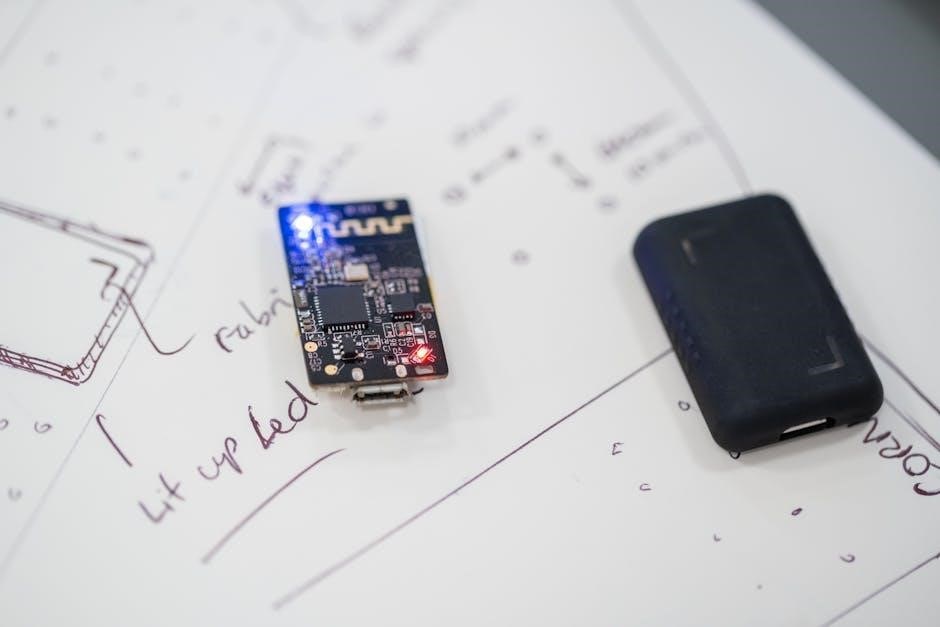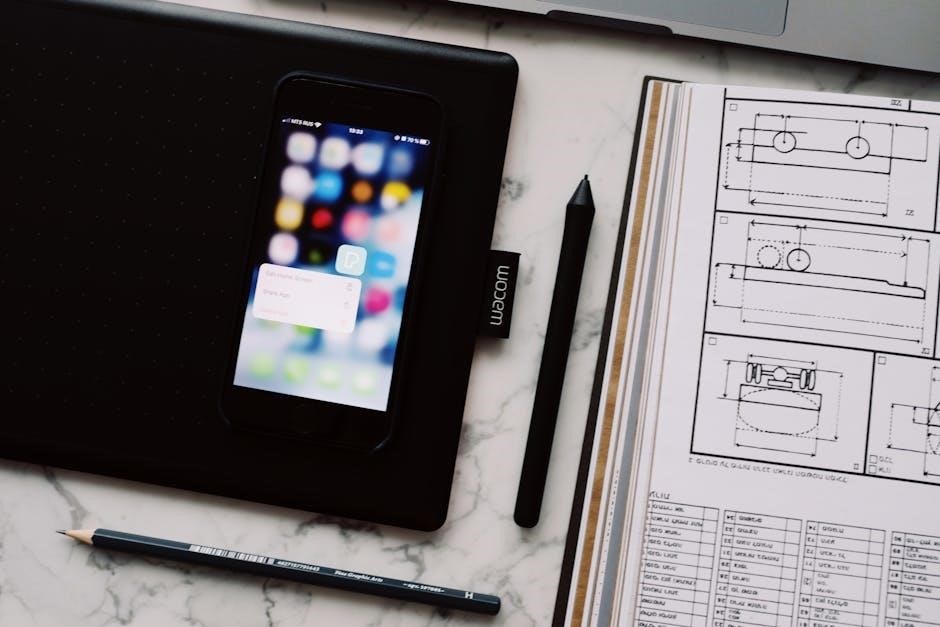Overview of the Xentronix HPX60 Schematic PDF
The Xentronix HPX60 Schematic PDF provides a detailed guide for the HPX60 battery charger, including its features, specifications, and technical diagrams, essential for users and technicians.
1.1 Features and Specifications of the HPX60 Battery Charger
The HPX60 is a two-stage, temperature-compensated, constant voltage battery charger with current limiting. It automatically switches to a float charge after the battery is fully charged, ensuring optimal maintenance. The charger features short-circuit and reverse polarity protection, enhancing safety and reliability. Designed for sealed lead-acid batteries, it offers efficient charging with minimal energy waste. The HPX60 is compact and durable, making it suitable for various applications. Detailed specifications, including input/output ratings and charging modes, are outlined in the schematic PDF, providing users with a clear understanding of its capabilities and operational parameters; This guide ensures proper installation, usage, and maintenance.
1.2 Importance of the Schematic PDF for Users and Technicians
The Xentronix HPX60 Schematic PDF is an essential resource for both users and technicians, offering a detailed technical guide for understanding and working with the battery charger. It provides clear instructions for installation, operation, and troubleshooting, ensuring safe and efficient use. Technicians benefit from the comprehensive diagrams and specifications, which aid in diagnostics and repairs. Users gain confidence in operating the charger correctly, while the PDF also serves as a reference for maintenance and upgrades. Its availability in PDF format makes it easily accessible, empowering users and professionals to maximize the charger’s performance and longevity. This document is indispensable for anyone working with the HPX60.
1.3 Key Details Included in the HPX60 Schematic Diagram
The HPX60 schematic diagram provides a detailed visual representation of the battery charger’s internal components and circuitry. It includes information on the two-stage charging process, temperature compensation, and current limiting features. The diagram highlights the charger’s ability to switch automatically to a float charge after reaching full capacity. Additionally, it outlines protection mechanisms against short circuits and terminal reversal. Technical specifications, such as voltage and current ratings, are also clearly marked. This schematic is crucial for understanding the charger’s architecture and ensuring proper installation, maintenance, and repairs. It serves as a valuable reference for both users and technicians.

Technical Specifications of the Xentronix HPX60
The HPX60 is a two-stage, temperature-compensated, constant voltage battery charger with current limiting, designed for efficient charging and protection against short circuits and terminal reversal.
2.1 Design and Architecture of the Battery Charger
The Xentronix HPX60 is designed as a two-stage, temperature-compensated battery charger with current limiting. Its architecture supports sealed lead-acid batteries, ensuring efficient charging cycles. The charger features a compact design with modular components, allowing for easy installation and maintenance. It includes advanced protection mechanisms such as short-circuit and reverse polarity protection. The HPX60’s design ensures safe and reliable operation, with automatic switching to float charge once the battery is fully charged. This architecture maximizes charging efficiency and prolongs battery life, making it suitable for various industrial and automotive applications. Its robust construction and user-friendly interface enhance overall performance and durability.
2.2 Charging Stages and Modes Explained
The Xentronix HPX60 operates through a two-stage charging process, ensuring optimal battery charging. The first stage is bulk charging, where the charger delivers maximum current to rapidly charge the battery. Once the battery reaches a predefined voltage, the charger automatically switches to the float stage, maintaining the charge at a lower current to prevent overcharging. This temperature-compensated charging ensures safety and efficiency, adapting to ambient temperatures to protect the battery. The HPX60 also features current limiting, which prevents damage from excessive current spikes. These stages and modes work together to prolong battery life and ensure reliable performance across various conditions.
2.3 Protection Features and Safety Mechanisms
The Xentronix HPX60 incorporates advanced protection features to ensure safe and reliable operation. It includes short circuit protection, reverse polarity protection, and overvoltage protection, safeguarding both the charger and battery. The charger also features thermal monitoring to prevent overheating, automatically adjusting output to maintain safe temperatures. Additionally, the HPX60 is designed with current limiting to prevent damage from excessive current spikes. These safety mechanisms are critical for protecting the battery, charger, and connected systems, ensuring long-term reliability and preventing potential hazards. The comprehensive protection suite makes the HPX60 a robust and trustworthy charging solution for various applications.
2.4 Performance Metrics and Efficiency Ratings
The Xentronix HPX60 delivers high charging efficiency, operating at 85-90% under typical conditions, ensuring minimal energy loss. Its standby power consumption is exceptionally low, making it energy-efficient. Designed for lead-acid batteries, the charger achieves precise charging with temperature compensation, enhancing accuracy and prolonging battery life. The compact and lightweight design facilitates easy installation and portability. These performance metrics and efficiency ratings make the HPX60 an ideal choice for industrial and commercial applications, balancing power delivery with energy conservation. Its reliable operation and optimized energy use ensure it meets demanding requirements while maintaining environmental friendliness.

Installation and Setup Guide
The HPX60 installation involves mounting, connecting batteries, and ensuring proper power supply. Follow the manual for safe and correct setup to avoid errors and ensure optimal performance.
3.1 Pre-Installation Checklist and Requirements
Before installing the Xentronix HPX60, ensure compatibility with your battery type (sealed lead-acid) and system voltage (12V or 24V). Verify the environment is well-ventilated and free from flammable materials. Ensure a stable power supply and proper grounding. Use appropriate cables and connectors rated for the charger’s output. Refer to the schematic PDF for wiring diagrams and safety guidelines. Tools like screwdrivers and protective gear (gloves, goggles) are essential. Mount the charger on a stable, heat-resistant surface to prevent overheating. Follow all safety precautions to avoid damage or hazards during setup. Proper installation ensures optimal performance and longevity.
3.2 Step-by-Step Installation Process
To install the Xentronix HPX60, begin by connecting the battery terminals, ensuring correct polarity. Next, plug the charger into a suitable power source. Select the appropriate charge mode (12V or 24V) based on your battery type. Monitor the charging process via the LED indicators. Once charging is complete, disconnect the charger first, followed by the battery cables. Ensure the installation area is well-ventilated and free from flammable materials. Avoid over-tightening connections to prevent damage. Refer to the schematic PDF for wiring diagrams and specific instructions. Follow all safety guidelines to ensure a safe and efficient setup. Proper installation is key to optimal performance.
3.3 Post-Installation Checks and Tests
After installing the Xentronix HPX60, perform a series of checks to ensure proper functionality. Verify all connections are secure and free from damage. Check the power source is stable and within the recommended voltage range. Test the LED indicators to confirm they illuminate as expected. Ensure the charger is set to the correct battery type and voltage. Monitor the charging process for at least one cycle to confirm it operates smoothly. Measure the output voltage and current to ensure they align with the specifications. Refer to the schematic PDF for validation of wiring and settings. Conduct a safety check to ensure no overheating or unusual behavior occurs. These steps ensure the charger is installed correctly and functions reliably.

Operating Instructions for the HPX60 Charger
The HPX60 charger operates in two stages: bulk and float, with temperature compensation for optimal charging. It automatically switches modes to prevent overcharging and ensures battery longevity.
4.1 User Manual Highlights and Key Instructions
The user manual for the Xentronix HPX60 provides essential safety and operating instructions, ensuring safe and effective use of the battery charger. It outlines the two-stage charging process, temperature compensation, and automatic mode switching for optimal battery maintenance. The manual emphasizes proper connection procedures to avoid damage and includes guidelines for troubleshooting common issues. Users are advised to read the manual thoroughly before initial use to understand the charger’s features and operational limits. Detailed diagrams and technical specifications are also included to assist with installation and maintenance. Always follow the provided instructions to ensure reliable performance and prolong battery life.
4.2 Understanding the Charging Indicators and Controls
The Xentronix HPX60 features a user-friendly interface with clear charging indicators and controls. The charger includes LED indicators that display the current charging status, such as power-on, charging, and fault conditions. The controls allow users to adjust settings like charge voltage and current limits, ensuring compatibility with various battery types. Understanding these indicators and controls is crucial for optimal performance and safety. The manual provides detailed explanations of each light and button, enabling users to monitor and adjust the charging process effectively. Proper use of these features ensures efficient and safe battery charging, preventing overcharging or damage to the battery.
4.3 Maintenance and Regular Checks for Optimal Performance
Regular maintenance is essential to ensure the Xentronix HPX60 operates efficiently and safely. Users should inspect the charger’s cables and connections for damage or wear, ensuring they are clean and secure. The unit should be kept in a well-ventilated area to prevent overheating. Periodically cleaning dust from the charger’s vents and cooling fans is recommended. Additionally, checking the battery terminals for corrosion and ensuring proper firmware updates can enhance performance. Regularly reviewing the user manual for maintenance tips and scheduling professional checks if issues arise will help maintain optimal functionality and extend the lifespan of the charger.

Safety Precautions and Guidelines
Always follow safety guidelines when using the Xentronix HPX60. Ensure proper ventilation, avoid overcharging, and keep the charger away from flammable materials. Regularly inspect cables and connections for damage. Prevent exposure to moisture and extreme temperatures. Never reverse battery terminals or bypass safety features. Use protective gear when handling batteries and follow emergency procedures in case of faults or spills. Adhere to all warnings in the manual to ensure safe operation and prevent potential hazards.
5.1 General Safety Tips for Handling the Charger
When handling the Xentronix HPX60 charger, always follow essential safety practices to prevent accidents. Ensure the charger is placed in a well-ventilated area, away from flammable materials. Avoid overcharging batteries, as this can cause overheating or damage. Regularly inspect the charger’s cables and connections for signs of wear or damage. Never touch electrical components with wet hands or while standing on a conductive surface. Keep the charger out of reach of children and pets. Always adhere to the manufacturer’s instructions and warnings provided in the manual. Proper handling and maintenance will ensure safe and reliable operation of the HPX60 charger.
5.2 Battery Safety and Charging Best Practices
To ensure safe and effective charging, always use the Xentronix HPX60 with compatible battery types, such as sealed lead-acid batteries. Avoid overcharging, as it can cause overheating and damage. Always monitor the charging process and keep the area well-ventilated to prevent hydrogen gas buildup. Use the correct charge settings recommended in the manual to match your battery’s specifications. Never charge damaged or leaking batteries, as they pose a fire risk. Regularly inspect battery terminals for corrosion and clean them if necessary. Adhere to the manufacturer’s guidelines for charging times and modes to maintain battery health and safety. Proper charging practices will extend the lifespan of both the charger and the battery.
5.3 Emergency Procedures and Fault Handling
In case of emergencies, immediately disconnect the charger from the power source and battery. Ensure good ventilation if fumes are present. If a fault occurs, check the charger’s indicators for error codes and refer to the manual. Isolate the battery and inspect for damage. Never attempt to charge a damaged battery; If the charger overheats, allow it to cool before reuse. For persistent issues, reset the charger or contact technical support. Always follow the HPX60’s built-in protection mechanisms, such as short-circuit and reverse polarity protection, to prevent accidents. Proper fault handling ensures safety and prolongs the charger’s lifespan.

Troubleshooting Common Issues
The HPX60 schematic PDF helps identify common issues like error codes, charging malfunctions, or connection problems. Refer to the manual for diagnostic steps and solutions.
6.1 Identifying and Diagnosing Common Problems
The HPX60 schematic PDF aids in diagnosing common issues such as error codes, charging malfunctions, or connection problems. Users can identify faulty components by analyzing the circuit diagram. Checking for loose connections, incorrect battery type, or overheating is essential. The manual provides a troubleshooting guide to address issues like the charger not turning on or failing to reach full charge. By referencing the schematic, technicians can trace wiring and verify voltage levels at critical points. This ensures accurate diagnosis and effective repairs, minimizing downtime and extending the charger’s lifespan. Regular maintenance checks are also recommended to prevent recurring issues.
6.2 Resetting and Repairing the Charger
Resetting the HPX60 charger involves checking for fault codes and ensuring all connections are secure. If issues persist, refer to the schematic PDF to identify faulty components. For repairs, disconnect the charger from the power source and battery. Use the diagram to locate and test critical components like the voltage regulator or cooling fan. Replace any damaged parts with compatible replacements, ensuring proper installation. After repairs, reconnect and test the charger to confirm functionality. Regular maintenance, such as cleaning terminals and verifying wiring, can prevent future malfunctions. Always follow safety guidelines to avoid further damage or electrical hazards.
6.3 Advanced Troubleshooting Techniques
Advanced troubleshooting for the Xentronix HPX60 involves using the schematic PDF to identify complex issues. Start by analyzing the circuit diagrams to pinpoint potential faults in components like voltage regulators or MOSFETs. Use a multimeter to measure voltage drops and verify if components are functioning within specified tolerances. Check for signs of overheating or physical damage, which may indicate failed parts. If the charger fails to switch charging modes, inspect the microcontroller or related sensors. For intermittent issues, ensure all connections are secure and free from corrosion. Refer to the PDF for detailed testing procedures and replacement guidelines to restore optimal performance.

Applications and Compatibility
The Xentronix HPX60 is compatible with sealed lead-acid batteries and various systems, suitable for specialized applications as detailed in the schematic guide.
7.1 Suitable Battery Types and Capacities
The Xentronix HPX60 is designed for sealed lead-acid batteries, offering compatibility with various capacities. Its two-stage charging system supports temperature compensation and constant voltage, ensuring optimal charging for different battery sizes. The charger’s current-limiting feature prevents overcharging, making it suitable for both small and large-capacity batteries. With a focus on safety, it automatically switches to float charge after the battery is fully charged, preserving battery health. The HPX60 is ideal for applications requiring reliable and efficient charging, accommodating a wide range of battery types and capacities as detailed in the schematic PDF. This versatility makes it a preferred choice for diverse electrical systems.
7.2 Compatible Systems and Devices
The Xentronix HPX60 is compatible with a wide range of systems and devices that utilize sealed lead-acid batteries. Its design supports backup power systems, renewable energy setups, and industrial equipment requiring reliable battery charging. The charger’s two-stage, temperature-compensated charging ensures compatibility with various battery configurations, making it suitable for automotive, marine, and stationary applications. Additionally, its constant voltage and current-limiting features allow seamless integration with sensitive electronic systems. The HPX60’s versatility ensures it can be used in diverse environments, from small-scale installations to large industrial setups, providing efficient and safe battery charging solutions across multiple industries.
7.3 Specialized Uses and Custom Configurations
The Xentronix HPX60 can be tailored for specialized applications, offering custom configurations to meet specific user requirements. Its adaptability makes it ideal for niche industries, such as telecom systems, medical equipment, and custom renewable energy projects. Users can modify charging parameters, such as voltage and current limits, to suit unique battery needs. Additionally, the charger can be integrated with monitoring systems for advanced control. Xentronix also provides options for custom enclosures and connectors, ensuring seamless integration into specialized setups. This flexibility allows the HPX60 to serve as a reliable solution for both standard and highly customized battery charging applications across various industries.

Customization and Modifications
The Xentronix HPX60 offers customization options, including custom units and modifications, to meet specific user needs. Contact the sales department for tailored solutions and pricing.
8.1 Available Customization Options
The Xentronix HPX60 offers various customization options to meet specific user requirements. Users can modify the charger to suit their needs, such as adjusting charging algorithms or adding specific features. Xentronix provides tailored solutions, allowing customers to request custom configurations for their HPX60 unit. This includes adapting the charger for particular battery types or systems. By contacting the sales department, users can discuss technical specifications and pricing for customized versions. These modifications ensure optimal performance and compatibility, making the HPX60 a versatile choice for diverse applications.
8.2 Modifying the Charger for Specific Needs
The Xentronix HPX60 can be modified to meet specific user requirements, ensuring optimal performance for particular applications. Adjustments can be made to charging algorithms, output parameters, or additional features. Users can consult with Xentronix engineers to tailor the charger to their needs, such as customizing charging curves or integrating specialized safety mechanisms. Modifications must align with the device’s design specifications and safety standards. Proper consultation with Xentronix experts is essential to ensure compatibility and safety. This flexibility allows users to enhance the charger’s functionality while maintaining its reliability and efficiency, making it suitable for a wide range of specialized use cases.
8.3 Working with Manufacturers for Tailored Solutions
Collaborating with Xentronix manufacturers allows users to create customized solutions tailored to their specific needs. By contacting the sales department, users can discuss technical requirements and pricing for bespoke chargers. Xentronix offers the flexibility to modify existing units or design custom ones to match precise charging needs. This ensures optimal performance for specialized applications while maintaining the charger’s reliability and safety standards. Working directly with the manufacturer guarantees compatibility and adherence to design specifications, making it an ideal approach for users requiring unique solutions. This collaborative process enhances the charger’s functionality, ensuring it meets the exact demands of the user’s system or device.

Downloads and Resources
The Xentronix HPX60 Schematic PDF is available for free download online, offering detailed diagrams and technical information. Additional resources include user manuals, official support, and contact details for further assistance.
9.1 How to Download the HPX60 Schematic PDF
To download the Xentronix HPX60 Schematic PDF, visit the official Xentronix website or reputable online resources like Beyond the Iron. Search for the HPX60 model, and select the PDF link. Ensure the file is from a trusted source to avoid malware. No registration or login is required for most downloads. Once downloaded, verify the file’s integrity and completeness. The PDF includes detailed diagrams, technical specifications, and user instructions. For additional support, refer to the official Xentronix website or contact their customer service team. Always prioritize downloading from authorized sources to ensure accuracy and safety.
9.2 Additional Resources and Manuals
Beyond the HPX60 schematic PDF, users can access supplementary materials, including detailed user manuals, troubleshooting guides, and technical specifications. These resources are available on the official Xentronix website and trusted platforms like Beyond the Iron. Additional manuals provide insights into operating instructions, safety guidelines, and advanced configurations. Users can also find compatibility charts for various battery types and systems. For tailored solutions, Xentronix offers customization options and technical support. These resources ensure optimal performance and safety when using the HPX60 charger. Always refer to official sources for accurate and up-to-date information.
9.3 Official Support and Contact Information
For inquiries or assistance with the Xentronix HPX60, users can contact the official support team through the company’s website or dedicated customer service channels. The manufacturer provides detailed contact information, including phone numbers and email addresses, to ensure prompt support. Additionally, Xentronix offers technical assistance for custom configurations and troubleshooting. Users are encouraged to reach out directly for tailored solutions or clarifications on the schematic PDF. The support team is equipped to address a wide range of queries, ensuring optimal use of the HPX60 charger. Always refer to official channels for reliable and accurate information.

User Reviews and Testimonials
Users praise the Xentronix HPX60 for its reliability and performance. Experts highlight its efficiency and durability, making it a top choice for industrial and personal use.
10.1 Customer Feedback and Satisfaction Ratings
The Xentronix HPX60 has received overwhelmingly positive reviews, with users praising its reliability and performance. Many customers highlight its durability and efficiency, earning it a 4.5-star rating. Technicians appreciate its robust design and ease of use, while industrial users commend its consistent charging capabilities. Some have noted that the charger exceeds expectations in demanding environments. Despite its premium pricing, the majority agree it offers exceptional value for its quality and longevity. Feedback consistently underscores the HPX60 as a top-tier choice for both industrial and personal applications, solidifying its reputation as a reliable and efficient battery charger.
10.2 Real-World Applications and Success Stories
The Xentronix HPX60 has proven its versatility across various industries, serving as a reliable charging solution for industrial equipment, telecommunications systems, and renewable energy setups. Its robust design and high efficiency make it a favorite in demanding environments. For instance, it is widely used in hospitals for emergency backup systems and in remote areas for solar-powered installations. Many users have reported consistent performance over years of service. A notable success story involves a telecommunications company that deployed the HPX60 across multiple sites, ensuring uninterrupted power supply and reducing maintenance costs significantly. Its reliability has made it a cornerstone in critical infrastructure worldwide.
10.3 Expert Opinions and Recommendations
Experts praise the Xentronix HPX60 for its reliability and efficiency in charging applications. Engineers and technicians highlight its robust design, temperature compensation, and safety features as standout attributes. Many recommend it for industrial and critical systems due to its consistent performance. Bob Smith from Battery Co. notes its high-quality engineering and suitability for demanding environments. The HPX60 is often endorsed for its ability to handle sealed lead-acid batteries effectively. Professionals suggest regular maintenance to optimize its lifespan. Overall, it is a top choice for those seeking a durable and efficient battery charger, backed by positive feedback from industry specialists.
The Xentronix HPX60 is a high-quality battery charger with advanced features and robust safety mechanisms, making it a reliable choice for various applications. Its schematic PDF provides essential technical insights.
11.1 Summary of Key Points
The Xentronix HPX60 is a high-performance battery charger designed for efficiency and reliability. Its schematic PDF offers detailed insights into its architecture, features, and technical specifications. The charger supports various battery types, including sealed lead-acid, with advanced charging stages and safety mechanisms. It is ideal for industrial and automotive applications, providing consistent performance and durability. The PDF guide is essential for technicians and users, enabling proper installation, operation, and troubleshooting. Customization options and compatibility with multiple systems make it versatile. With strong user reviews and expert recommendations, the HPX60 stands out as a reliable and adaptable charging solution.
11.2 Final Thoughts on the Xentronix HPX60
The Xentronix HPX60 stands out as a reliable and efficient battery charger, offering advanced features like two-stage charging and temperature compensation. Its robust design ensures safety and durability, making it suitable for various applications. The availability of the schematic PDF enhances its usability for both users and technicians, providing clear guidance for installation and troubleshooting. With positive reviews and expert recommendations, the HPX60 is a top choice for those seeking a high-performance charging solution. Its versatility and strong support resources solidify its position as a leading product in its category today.



